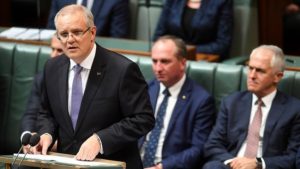Federal budget –the good, the bad and the ugly
Like your generous but mad aunt at Christmas, there are things to like and dislike about the 2017-18 Federal Budget.
And there are important ramifications both positive and negative for people in the culturally and linguistically diverse (CALD), refugee and humanitarian sectors.
The budget confirms the government’s commitment to expand Australia’s refugee intake to 16,250 places in the coming year and then to 18,750 in 2018-19.
Migration levels will remain stable at about 190,000 people.
But from July 1, 2017, the Government will allocate up to 1,000 places from the Humanitarian Program to a new Community Support Program – which has already been the subject of a pilot initiative.

This will save the government $26.9 million over four years but refugee advocacy groups say the places should be offered in addition to Australia’s humanitarian intake.
The Community Support Program allows individuals, groups and businesses to sponsor humanitarian entrants to Australia. In return, sponsors will be required to support humanitarian entrants during their first year in Australia, including by funding their visa application, airfares and settlement services.
The federal budget also outlines new residency requirements for age and disability pensions will require claimants to have up to 15 years of continuous Australian residence to be eligible for these payments.
Nearly 40 per cent of people receiving the age pension were not born in Australia and CALD advocacy groups say the provisions will disproportionately impact Australians of CALD backgrounds.
Also in the budget is a levy on employers who recruit overseas on temporary and permanent visas. The levy will provide funds to support skills development in the Australian workforce.
Employers will pay up to $5000 for every foreign worker they hire.
CALD advocacy groups say the ‘Skilling Australians Fund Levy’ implies that migrant workers are responsible for Australia’s skills gap and will threaten social cohesion.
They say migrant workers are some of Australia’s most vulnerable to the risk of abuse and exploitation by their employers and the levy presents new risks to migrant workers including salary deductions and a rise in racism and discrimination.
But the ‘Skilling Australians’ initiative is worth $1.5 billion and amounts to an eleventh-hour reprieve for vocational education and training which aims to deliver an additional 300,000 apprenticeships and traineeships over the next four years.
The fund will require the states and territories to match the cash injection and will give priority to occupations in high demand and to rural and regional areas.
Also in the budget is a new tax levied on foreign home owners who leave their properties vacant and increased capital gains tax for foreign investors.
The immigration processing centres of Manus Island and Nauru will get an extra $21 million as the relocation of asylum seekers to the US ramps up.
Planned changes to paid parental leave have been scrapped in the 2017-18 budget meaning 70,000 families will now not have their payments scaled back.
And first home buyers will be able to salary sacrifice money put aside to save for a deposit.
Overall, the budget is imposing $23 billion in tax hikes on banks, workers and foreign investors but it is forecast to help reduce the national deficit from $38 billion to $29 billion in the coming year and to deliver a surplus in 2020-21.
Politically, the budget is seen as a big-spending, big taxing exercise forced upon the coalition by its failure to get spending cuts through the senate.
It appears to be a remedy to the political fallout and falling popularity the government suffered after the 2014-15 budget which was widely rejected for being too austere.
There are many measures in the budget which will work towards better social equity but also some that won’t.
Securing of funding for the National Disability Insurance Scheme by raising the Medicare levy 0.5 per cent for most Australians and will improve services for people with disabilities and their families.
And the needs-based approach to school funding in ‘Gonski 2.0’, will ensure students in disadvantaged areas get better opportunities to access quality education.
The federal government has also committed $55.7 million over five years to boost indigenous employment.
One of the most crucial factors in this package is a $17.6 million investment for employment assistance for indigenous people exiting prison.
The over-representation of Indigenous people in the prison system is an interminable issue and efforts to strengthen employment opportunities for people leaving the system are probably the most effective way to prevent re-offending.
But there are also measures that will make life harder for welfare recipients – often the nation’s most vulnerable people.
One proposal outlined in the budget is a demerit point system where welfare recipients lose points — and can eventually have their payments cut — for missing appointments or other breaches.
Another proposal is a trial of ‘random’ drug testing for new welfare recipients, with people who test positive facing their payments being restricted to a cashless card and potentially having their payments cut after a ‘third strike’.
Humanitarian organisations have reacted to these proposals by saying the government’s focus should be on addressing the circumstances of people on the margins and supporting them to find pathways to sustainable education, training and employment rather than punishing them.
Treasurer Scott Morrison said the budget showed the government was living within its means.
“This budget is about making the right choices to secure the better days ahead. Our choices are based on the principles of fairness, security and opportunity,” Mr Morrison said.
Laurie Nowell
AMES Australia Senior Journalist












